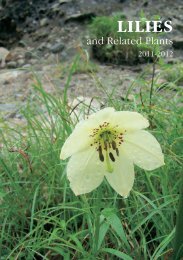LILIES - RHS Lily Group
LILIES - RHS Lily Group
LILIES - RHS Lily Group
Create successful ePaper yourself
Turn your PDF publications into a flip-book with our unique Google optimized e-Paper software.
gave one flower, but the bulb unfortunately rotted that winter. I think L.majoense<br />
needs excellent drainage, and may even have to be covered in winter to keep<br />
away excess water.<br />
In 2005, I also tried a newly introduced rarity from Vietnam, Lilium poilanei. This<br />
lily, which produces a very large fragrant trumpet, that is white within and purple<br />
red on the outside, grew very well in a humus rich soil, planted in a sunny site, but<br />
with its stem roots shaded by perennials. It produced a large number of offsets.<br />
North American lilies<br />
Finally, I come to the North American and USA species, which include some<br />
of my favourite lily species, but also, the ones I have had the most problems<br />
in growing. These lilies, for the most part, are so well suited to their original<br />
climates, that unless these conditions can be recreated, I find that they tend to<br />
dry out, or rot, or simply sulk for many seasons, never producing any growth.<br />
This is the case with Lilium canadense, which I have now been trying to grow<br />
for six years, in both acid and neutral soil, in a sunny and half shaded position,<br />
but it never seems to want to produce any above ground growth or roots, and<br />
the rhizomatous bulbs often disintegrate and disappear. A Lilium canadense that<br />
I grew this year from a bulb obtained at the <strong>Lily</strong> <strong>Group</strong> bulb auction grew well,<br />
however it mysteriously totally died away just a few days after I had sprayed<br />
it with a general insecticide against some aphids which were attacking it. Two<br />
others are growing in a more shaded part of the garden, where they produce<br />
stems, but no flowers. However, I will not give up growing this species, since it<br />
is one of my favourites.<br />
I have also been trying to establish one of my favourite lilies, Lilium superbum,<br />
since 2001. However, when I purchased some magnificent large Lilium superbum<br />
bulbs at the <strong>Lily</strong> <strong>Group</strong> bulb auction in October 2005, grown by Tim Whiteley,<br />
I realised that the problem with my past attempts at growing this lily was that<br />
the bulbs I had been buying had been far too small and weak to be able to root<br />
and establish. They were also much more sensitive to dryness and rot, since they<br />
never really had any strong root run. The bulbs from Tim Whiteley did much<br />
better, flowering regularly every July. It is a shorter variety of Lilium superbum,<br />
only reaching about 180 cm tall. To combine this variety with the taller ones<br />
might be something to try this autumn? Lilium pardalinum and Lilium volmeri<br />
seem to be two USA species that adapt fairly well to the Swiss climate, growing<br />
well, but quickly going dormant when the temperatures become too warm or too<br />
dry for their taste. Lilium pitkinense grows fairly well, but has not flowered yet.<br />
It seems to dislike dry conditions, preferring moist, half shady ones.<br />
Last autumn I finally got my hands on some very good bulbs of Lilium<br />
washingtonianum and L. washingtonianum purpurascens. They were young<br />
63




